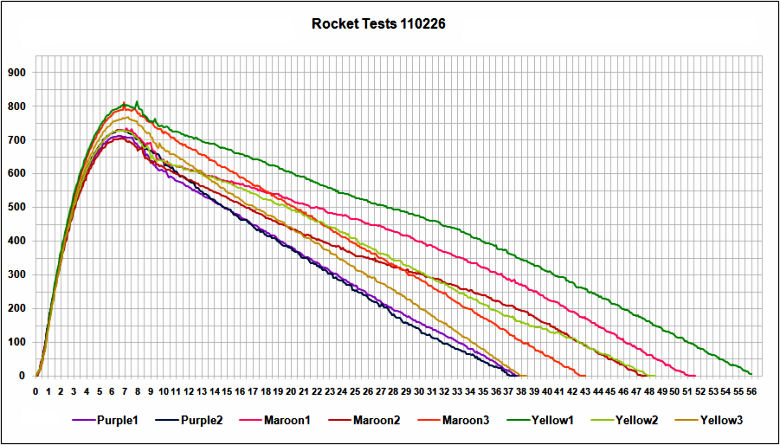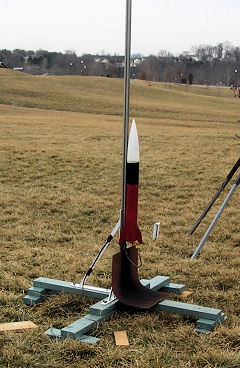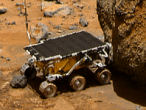|
 Six
members from teams 9212, 91214, and 9215 traveled to the
Maryland launch site on Saturday, February
26.
Team 9213 was not able to participate. The
weather was seasonable cold (45f) and the wind was very
light (about 5mph). We
used the long launch rail for all flights. The launch
tower was angled about 3 degrees with the wind. We conducted
eight test launches. Team 9212 (Yellow rocket) and Team 9214 (Purple rocket) took a try at
early qualification. Six
members from teams 9212, 91214, and 9215 traveled to the
Maryland launch site on Saturday, February
26.
Team 9213 was not able to participate. The
weather was seasonable cold (45f) and the wind was very
light (about 5mph). We
used the long launch rail for all flights. The launch
tower was angled about 3 degrees with the wind. We conducted
eight test launches. Team 9212 (Yellow rocket) and Team 9214 (Purple rocket) took a try at
early qualification.
Objectives:
- Teams 9212 and 9215 will test new boosters.
- Conduct one test and one early qualification
flight for teams 9212, 9213, and 9214.
- Look into parachute modifications to correct
floating.
Lessons and Actions:
-
The launch tower was angled about 3 degrees with the light wind.
All eight E30 flights
were straight up.
- All flights with the E30-7T were around 750ft.
The weight of the rockets seems to be a critical factor for hitting
750. One gram appears to adjust the altitude about 3 feet. While the
rockets are similar, the target weight to hit 750ft is different for
each rocket.
- None of the eggs cracked.
- We continued to have problems with igniters. The AeroTech igniter clip worked OK, but
we still had failures. We used some Quest igniters. We had one fire
but fail to ignite the engine. We waste a lot of time and introduce
risk with installing an igniter at the launch tower. We have no
solution. When you go to the launch tower, you need to take at least
one additional igniter.
- We recovered all the rockets from the fields and
the trees. The
NAR members provided help with a long pole. Maybe we should buy one.
- Used our new wind meter.
- It became apparent that the terrain is important
in the descent times. When we descend into the valley, the descent
times go up about 2 seconds because of the extra 40 feet. This hurt
us two weeks earlier, but this time it helped. We need to consider
the terrain and the direction of the wind.
- We tried two parachutes modifications. Team 9212
bound two shrouds together and it reduced the descent times by
several seconds. We are not sure this is legal, but we weren't
called on it. Team 9215 put 6 holes in their chute. It also reduced
the descent time by several seconds. This is legal. Both
modifications appear to have reduced the floating that we have seen
in the past few weeks.
- We produced detailed data analysis for weight predictions
and parachute modifications.
Launches:
|
Team |
Rocket |
Engine |
Cargo |
Cargo Recovery |
Booster Recovery |
Weight |
Results |
Comments |
|
9212 |
Yellow
test 1 |
E30-7T |
egg,
altimeter J |
15in hemi-chute |
attached |
370g |
815ft, 57sec
(video) |
New booster, too high, chute floated |
|
9214 |
Purple
test 1 |
E30-7T |
egg,
altimeter F |
15in hemi-chute |
attached |
397g |
713ft, 38sec
(video) |
Nice flight, landed low in tree |
|
9215 |
Maroon
test 1 |
E30-7T |
egg,
altimeter H |
15in hemi-chute |
attached |
387g? |
734ft, 52sec
(video) |
Old booster, squirrely flight, chute floated |
|
9212 |
Yellow
test 2 |
E30-7T |
egg,
altimeter J |
15in hemi-chute |
attached |
397g |
729ft, 49sec
(video) |
Nice flight, chute floated |
|
9214 |
Purple
test 2 |
E30-7T |
egg,
altimeter F |
15in hemi-chute |
attached |
385g |
730ft, 39sec
(video) |
Nice flight,
Qualification 23.03 |
|
9215 |
Maroon
test 2 |
E30-7T |
egg,
altimeter H |
15in hemi-chute |
attached |
395g? |
706ft, 48sec
(video) |
New booster, too low, chute floated |
|
9212 |
Yellow
test 3 |
E30-7T |
egg,
altimeter J |
15in hemi-chute, choked |
attached |
392g |
768ft, 39sec
(video) |
Nice flight, no float
Qualification 19.80 |
|
9215 |
Maroon
test 3 |
E30-7T |
egg,
altimeter H |
15in hemi-chute,
w/ holes |
attached |
375g? |
813ft, 44sec
(video) |
No float |
Altimeter Data
(Excel format)

Pictures:
Maroon Rocket
Yellow Rocket
Purple Rocket
 

|
|



